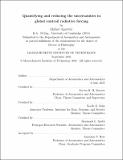Quantifying and reducing the uncertainties in global contrail radiative forcing
Author(s)
Agarwal, Akshat
DownloadThesis PDF (3.566Mb)
Advisor
n/a
Terms of use
Metadata
Show full item recordAbstract
Condensation trails, or contrails, are line-shaped ice clouds that form in the exhaust plume of aircraft engines under sufficiently cold and humid conditions. They can persist for several hours, growing to be indistinguishable from natural cirrus clouds. Numerical simulations of contrails (including contrail-cirrus) have estimated the global, annual average, net radiative forcing (RF) to be 50 mW/m² in 2011, representing 2.3% of the RF due to all anthropogenic emissions. However, these estimates are uncertain and model estimates vary by more than one order of magnitude. In this thesis, I address three major sources of uncertainty: the number of black carbon (BC) particles emitted by an engine, the accuracy of the meteorological datasets used for modeling contrails, and the approach to simulate the evolution of a contrail.
The number of BC particles emitted by an aircraft engine is required to estimate the number of crystals that form in a contrail. Decreasing the number of crystals that form by 80% could reduce the contrail RF by 50%. The first part of this thesis develops an approach to estimate the number of particles emitted by an engine. Using two complementary datasets, I relate smoke number measurements to the BC mass concentration, quantify losses in the measurement system, and connect mass emissions to particle number emissions. The method is applied to existing BC measurements achieving an 𝑅² of 0.80 and 0.82, respectively. Global BC emissions for all operations in 2015 were estimated to be 2.0 Gg/year (95% CI = 1.7 − 2.3) and 2.42 × 10²⁶ particles/year (95% CI = 1.58 − 3.81 × 10²⁶).
Contrail formation is sensitive to the background atmospheric conditions, specifically the temperature and humidity. These are estimated from reanalysis models that assimilate observations with numerical estimates of the atmosphere. Upper tropospheric water vapor has been found to be overestimated in multiple reanalyses, but the effect on the formation of persistent contrails has not been quantified. In the second part of this thesis, I quantify the error in predicting the formation of persistent contrails using two reanalysis models - ERA5 and MERRA-2. Using data from 793,044 radiosondes, persistent contrails forming at cruise altitudes in 30°N – 60°N are overestimated by factors of 2.0 and 3.5 for ERA5 and MERRA-2, respectively. I also define the evaporation depth, which measures the depth to which a contrail can survive based on the available ice mass and is thus a measure of contrail lifetime. This metric is found to be overestimated by 17% in ERA5 and 45% in MERRA-2 suggesting the contrail lifetime is overestimated. Finally, the reanalyses incorrectly identify individual regions that could form persistent contrails 87% and 52% of the time, respectively. These results suggest that contrail models currently overestimate the number and lifetime of persistent contrails.
Global contrail models simulate contrail evolution using simplified approaches. These may not capture important physical phenomena of the contrail, such as the size distribution of contrail ice particles, that more detailed simulations can. In the final part of this thesis, I use an intermediate-fidelity model, the Aircraft Plume Chemistry, Emissions, and Microphysics Model (APCEMM), to quantify the global RF using statistical inference, where samples are randomly drawn from the distance flown by aircraft in 2016. The global, annual average, net contrail instantaneous RF in 2016 was found to be 96 mW/m², within 6% of other literature estimates. The contrail energy forcing per unit flown was highest for flights over Western Europe, which was 39% and 66% higher than that for flights over the contiguous United States and South and East Asia, respectively. I also used the particle emissions approach as an input to APCEMM and found it had a correlation coefficient of 0.53 with the initial number of crystals that form in the contrail. In comparison, it had a smaller correlation coefficient of 0.10 with the energy forcing per contrail, suggesting that reducing particle number emissions may not have a strong effect on contrail RF. Finally, the effect of the overestimate in PCC in the MERRA-2 data was studied and found to reduce the global, annual average, net RF by a factor of 2.8 from 96 mW/m² to 30 mW/m². This difference could have important implications in identifying the most important climate forcers to focus on to reduce aviation’s climate impact, but further research is required to quantify it more thoroughly
Date issued
2021-09Department
Massachusetts Institute of Technology. Department of Aeronautics and AstronauticsPublisher
Massachusetts Institute of Technology